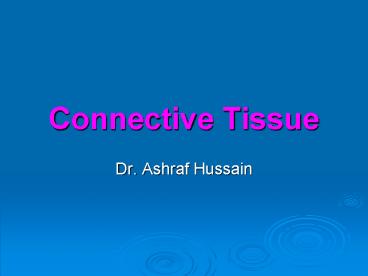Connective Tissue PowerPoint PPT Presentation
1 / 52
Title: Connective Tissue
1
Connective Tissue
- Dr. Ashraf Hussain
2
(No Transcript)
3
(No Transcript)
4
Connective Tissue
- These tissues connect and support other tissues
of the body
5
Connective Tissue
- Mechanical support
- Medium for exchange of nutrients waste products
- Energy store and thermal insulation
- Defensive functions
- a) Barrier b) Engulf bacteria
- c) Antibodies
6
(No Transcript)
7
Connective tissue
- Connective tissue comprises a diverse group of
cells embedded in a tissue-specific extracellular
matrix - Different type of connective tissue are
responsible for a variety of functions - Classification of connective tissue is based on
the composition and organization of its cellular
extracellular components and on its functions
8
(No Transcript)
9
Structure of connective tissue
- Cells
- Intercellular substance or matrix
10
Matrix
- Amorphous ground substance
- Thread like formed elements called fibers
(collagen fibers, reticular fibers, elastic
fibers) - Tissue fluid
11
Cellular component interspersed in intercellular
substance different kinds of cells Fibers
part of the formed substance of C.T. embedded
in ground substance Matrix ground substance
fibers
12
Connective tissue cells
- Resident cell population
- Fibroblasts
- Macrophages
- Adipose cells
- Mast cells
- Undifferentiated mesenchymal cells
- Wondering cell population
- Lymphocytes
- Plasma cells
- Neutrophils
- Eosinophils
- Basophils
- Monocytes
13
Leucocytes in loose supporting tissueF-Fibroblast
s, Er-Erythrocytes, N-Neurtrophils,
Eo-Eosinophils, L-lymphocytes, P-Plasma cells,
M-Macrophages
14
Connective tissue cells
- Fibroblasts
- Histiocytes (Macrophages)
- Plasma cells
- Mast cells
- Fat cells
15
(No Transcript)
16
(No Transcript)
17
ADULT CONNECTIVE TISSUE COMPONENTS Connective
Tissue Cells
18
Connective tissue cells
- Fibroblasts
- Most abundant
- Appearance varies in relation to functional state
- Produce connective tissue fibers secrete ground
substance
19
Mature Fibroblasts
20
Active fibroblasts
21
Histiocytes (Macrophages)
- Abundant
- Inactive and active histiocytes
- Scavenger cells
- Foreign body giant cells
- Antigen presenting cells
22
Macrophage
23
Plasma cells
- Generally rare but numerous at certain sites
e.g., intestinal mucosa, lymphoid organs - Nucleuscart wheel appearance
- Production of antibodies
24
(No Transcript)
25
Mast cells
- Mast well fed (German)
- Abundant in loose connective tissue around blood
vessels - Secrete Heparin ( anticoagulant)
- Histamine (vasodilator)
26
Mast Cells
27
Fat cells (adipocytes)
- Form adipose tissue when accumulate together
- Signet ring appearance
28
(No Transcript)
29
- Blue dotted lines - Adipocytes
- Orange Arrows - Fat droplet "space"
- Green Arrow - Nuclei of Adipocyte
30
Connective tissue fibers
- Long slender protein polymers which are found in
differing proportions in various types of
connective tissue - Predominant fiber type is responsible for
conferring specific properties to the tissue
31
Connective tissue fibers
- Collagen fibers --collagen
- Reticular fibers --collagen
- Elastic fiber -------elastin
32
Collagen
- Long moleculetropocollagen
- Three polypeptide chains intertwined together
triple helix - By now 19 varieties of collagen have been
identified - Most important best studied are I,II, III, IV
V.
33
Growth of molecular character of a collagen fibril
34
Collegen fibers are most abundant type of
connective tissue fibers
- Collagen fiber formation involves events that
occur both within and outside the fibroblast
35
Collagen fibers
- Diameter (2-10 micrometer)
- Run randomly in various directions
- In many parts, collagen fibers lie parallel to
each other forming bundles of various sizes - Flexible but inelastic (non-extensible)
- Pink colour with HE stain
36
Blue arrow - Collagen BundleGreen Arrow -
Fibroblast nuclei
37
Reticular fibers
- Reticular fibers provide a supporting framework
for the cellular constituents of various tissues
and organs - Reticular fibers are named for their arrangement
in a mesh-like pattern or network
38
Reticular fibers
- Very thin branching fibers (retenet)
- Diameter (0.5 to 2 micrometer)
- Coating of proteoglycans glycoproteins black
colour with silver staining, red with PAS - Abundant in connective tissue around muscle
fibers, nerve fibers, acini of glands, lymphoid
organs bone marrow
39
(No Transcript)
40
(No Transcript)
41
Elastic fibers
- Highly elastic can stretch one and half time
their original length - Diameter (0.2 to 1.0 mic.m)
- Branch rejoin to form loose network
- Found in lungs, large arteries, ligamenta flava
(connecting laminae of successive vertebrae)
42
(No Transcript)
43
(No Transcript)
44
Elastin fibres
45
Ground substance
- Ground substace occupies the space between the
cells and fibers - Ground substance consists largely of
proteoglycans and hyaluronic acid - Proteoglycans and Glycosaminoglycans (GAG) are
responsible for the physical properties of ground
substance
46
Embryonic connective tissue
- Develops from mesoderm is known as Mesenchyme
- Composed of star-shaped cells which lie in an
abundant relatively homogeneous intercellular
substance - Mucous tissue Whartons jelly
47
Arrows cells in mitosis C small blood
vessels Ground substance devoid of fibers Cell
processes extend into homogeneous ground substance
48
(No Transcript)
49
(No Transcript)
50
Disorders of connective tissue
- Marfan syndrome - a genetic disease causing
abnormal fibrillin - Scurvy - dietary deficiency in Vit.C leading to
abnormal collagen. - Ehlers-danlos syndrome - a genetic disease
causing progressive deterioration of collagens
affecting different sites in the body such as
joints, heart valves arterial walls
51
Disorders of connective tissue
- Osteogenesis imperfecta ( brittle bone disease)
insufficient production of good quality collagen
to produce healthy, strong bones - Spontaneous pneumothorax collapsed lungs,
believed to be related to subtle abnormalities in
connective tissue
52
(No Transcript)

